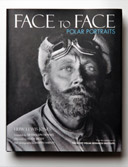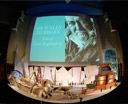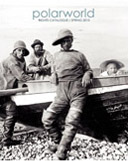 Our ProductsOur Resources |
This website requires the free Flash plugin to be installed.
Polarworld - discover more polar booksThe Arctic Book Review Exploring Other Worlds: Exploring Other Worlds:Margaret Fox, Elisha Kent Kane, and the Antebellum Culture of Curiosity David Chapin The independent scholar David Chapin’s first book is an intriguing and mostly successful attempt to put the well-known romance between the Arctic explorer Elisha Kent Kane and the spirit medium Margaret Fox into the larger context of American popular culture of the 1840s and 50s. Kane’s two Arctic expeditions made him a major celebrity who packed lecture halls and whose books sold in the hundreds of thousands. Margaret Fox, along with her sister Kate, had invented "spirit rapping" – a knocking sound produced by a resonant cracking of the big-toe joint – as a childhood prank, and when their older sister Leah became involved they had milked it for all it was worth, convincing their gullible parents, and an ever-widening circle of townsfolk in rural western New York, home of many a religious revival, that they really were in communication with spirits. They eventually developed a stage show, and a more intimate, drawing-room version for a more select clientele, that presented itself as an opportunity for the public to interrogate the spirits through the Fox sisters, using the simple binary code of a "knock" meaning yes, and silence meaning no. There was also an element of challenge: the public were invited to try to unmask any deception, either through working out how the sounds were produced, or in asking questions that the supposedly omniscient spirits could not answer correctly. Exploring in the Arctic and presenting scéances don’t strike us today as having a great deal in common, but Chapin’s thesis is that in the mid-19th century United States they – along with many other subjects – were linked by what he calls a "culture of curiosity". A growing number of public events, usually lectures or demonstrations in theatres, were aimed at satisfying a public demand for events that ranged from the self-improving and educational to the simply entertaining. The common theme among all these performances was that they appealed to the public’s curiosity to come and investigate something new – and that could be a lecture on communication with the spirit world as much as one on the unknown realm of the Arctic. Both were equally remote from most people’s everyday experience, and in the age’s general climate of belief, most people saw no more a priori reason to doubt the existence of the former than of the latter. Strangely to modern ears, communication with spirits was presented as being a new frontier of human advancement, comparable to the discovery of a new element or the invention of the telegraph – as if spirits broadcast at some wavelength that humanity had simply lacked the technology to detect before. In the broadest sense, therefore, spirit rapping demonstrations were regarded as scientific experiments held in public. The phenomenon had begun in 1848, and so emerged just too late to be covered in Charles Mackay’s Extraordinary Popular Delusions and the Madness of Crowds, but its extravagant silliness makes spirit rapping fully worthy of being included alongside Mackay’s disquisitions on Tulipomania, the Convulsionaries of St Medard, and the king of Bavaria’s edict against moustaches. Chapin presents the culture of curiosity as a peculiarly American phenomenon, which he does by linking it to the idea that Americans of that time very consciously thought of democracy as being the key, even uniquely identifying characteristic of their society (the peroration of the Gettysburg Address – "government of the people, by the people, for the people" – perhaps best encapsulates this). This was interpreted as meaning that everyone had the right as a citizen to inform themselves about new things and come to their own conclusions based on the evidence presented. The implication of this view was that the public were the arbiters of the demonstration’s truth or falsehood, success or failure, and that because the truth would be obvious to all who saw it, the majority view would therefore be the correct one. But cultures of curiosity arose at other times and places in which this self-conscious motivation of democratic empowerment was not noticeably a factor, and Chapin offers no analysis that would answer the question why. Public lectures and popular entertainment did not emerge, fully formed like Athena from the head of Zeus, in the mid-19th century United States. People had been going to public lectures as a means of self-improvement since the early 18th century, and the transition to a mass audience and public spectacle had already taken place by the early decades of the 19th century, as Alexander von Humboldt lectured to huge audiences in Berlin, Michael Faraday performed his sensational experiments at the Royal Institution in London, and Franz Gall gave his showy anatomy demonstrations in Paris. Chapin mentions Humboldt as a model of scientific enquiry that Kane consciously emulated, but strangely does not mention his influence in the realm of the public lecture. By the time that Chapin is describing as the origin of this phenomenon, it was already entering the phase that Herman Hesse would later characterize as one of decay: the "Age of the Feuilleton" – the corruption of rational inquiry by a public hungry for trivial factoids and sensation but careless of actual content. It would be hard to think of a better illustration of intellectual decay than an exhibition of toe-joint cracking masquerading as a scientific investigation of the numinous, but Chapin does not provide the wider context that would have made his analysis stronger and given it deeper resonances. The comparison of Kane’s and Fox’s mode of presentation also glosses over a couple of important dissimilarities between what they were doing. For Kane, travel and exploration were the primary activities; presenting lectures about them was secondary. Fox, by contrast, was not presenting to the public a report on some activity carried out elsewhere; the public presentation was the thing itself. As a consequence, Kane was delivering information to his audience as a figure of authority, while Fox was conducting an inquisitorial process that invited others to ask questions and interpret what they saw for themselves. People who set themselves up as professional debunkers of spiritualism, such as Chauncey Burr, were rejected because they appeared to be usurping the authority of the audience to decide on the validity of spirit rapping (so much for truth rising to the surface). Yet Kane was respected and revered for his authoritative delivery. This contradiction suggests that the emphasis should perhaps be on varieties of audience, and diverse expectations of different kinds of events, rather than on similarities that may be more apparent than real. Chapin’s major strength is as a narrative historian, and his summaries of Kane’s travels, the Fox sisters’ creation of a phenomenon that got out of control, and the off-again, on-again romance of Kane and Margaret Fox, are well-paced and authoritative, though Chapin’s prose style is utilitarian, sometimes verging on the monochrome. The author is at his best in describing the tortured social conventions that governed Kane’s and Fox’s private relationship. Kane’s attitude to Fox, as to the Inuit, was one of affectionate condescension. He was clearly enamoured with her, but the almost open distaste with which he described to her the idea that their connection might become known to his family reveals his emotional immaturity, and makes one wonder what she saw in him. Had he survived, the questions of whether he would have had the courage to acknowledge their relationship in public, and how long she would have put up with his condescension, are both completely open. Only an incorrigible optimist would have put money on a happy outcome. Chapin’s survey of Kane and Fox in the social and cultural landscape of mid-19th century America is a fine one, but the "culture of curiosity" is perhaps too diffuse and makeshift an idea to shed much light on the heterogeneous public activities that they engaged in, or to place those activities in the longer, wider historical view that they surely inhabit. |
|
||
follow us  | join us | join us  | home | contact | home | contact
|
||||
|
© Copyright Polarworld Ltd
SiteWizard.co.uk Web Site Design Company |
||||


